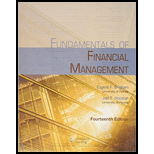
a.
To calculate: Present value of
Annuity: It is an agreement under which a person pays the lump sum payment or number of small transactions and in return he gets the amount at later date or upon annuitization. The purpose of the annuity is not to the break the flow of income after retirement.
a.
Explanation of Solution
Solution:
Formula to calculate present value of
Where,
- PV is present value.
- C is monthly payment made.
- I is interest rate.
- N is number of years.
Substitute $400 for C, 10% for I and N for 10 in equation (I).

The amount of present value will be $2457.8284.
b.
To calculate: Present value of
b.
Explanation of Solution
Solution:
Substitute $200 for C, 5% for I and N for 5 in equation (I).
The amount of present value will be $865.8954.
c.
To calculate: Present value of
c.
Explanation of Solution
Solution:
Formula to calculate present value of
Where,
- PV is present value.
- C is monthly payment made.
- I is interest rate.
- N for number of years.
Substitute $400 for C, 5% for I and 4, 3, 2, 1 and 0 for N.
The value of
d.
To calculate:
d.
Explanation of Solution
Solution:
Formula to calculate
Where,
- PV is present value.
- C is monthly payment made.
- I is interest rate.
- N is number of years.
Substitute $400 for C, 5% for I and 10 for N.(part (a))
The amount will be $2,703.61348 for annuity due.
Substitute $200 for C, 5% for I and 5 for N. (part (b))
The amount will be $909.190 for annuity due.
Formula to calculate annuity due amount is, (part (c))
Where,
- PV is present value.
- C is monthly payment made.
- I is interest rate.
- N for number of years.
Substitute $400 for C, 0% for I and 4, 3, 2, 1 and 0 for N.
The final amount of
Want to see more full solutions like this?
Chapter 5 Solutions
Fundamentals Of Financial Management
- Ends Apr 27 Explain why we start with Sales forecasts when we do our financial forecasting. What are the limitations of the Percent of Sales Forecasting method?arrow_forwardDescribe in detail what exactly is the Cash Conversion Cycle, how is it computed and what is the purpose of this calculation (how is it used).arrow_forwardExplain what Interest Rate Parity is, how it is calculated, and why it is important to a company operating internationally.arrow_forward
- Compare and contrast the three core means of adding shareholder wealth; Cash Dividends, Stock Dividends and Stock Splits, and Stock Repurchases. Include the various advantages and disadvantages of each one.arrow_forwardHow to calculate the future value?arrow_forwardhow to caculate the future value?arrow_forward
- what are some of the question can i asek my prinsiple of finance teache?arrow_forwardA critical discussion of the hockey stick model of start-up financing should be presented, supported by recent in-text citations. Provide a detailed explanation of the model. Describe each of the three stages of the hockey stick model of start-up financing, including a detailed characterisation of each stage. The characterisation of each stage should detail the growth, risk, and funding expectations. Present a critical evaluation and an insightful conclu sion.arrow_forwardQuestion Workspace Check My Work New-Project Analysis The president of your company, MorChuck Enterprises, has asked you to evaluate the proposed acquisition of a new chromatograph for the firm's R&D department. The equipment's basic price is $64,000, and it would cost another $18,000 to modify it for special use by your firm. The chromatograph, which falls into the MACRS 3-year class, would be sold after 3 years for $28,400. The MACRS rates for the first three years are 0.3333, 0.4445 and 0.1481. (Ignore the half-year convention for the straight-line method.) Use of the equipment would require an increase in net working capital (spare parts inventory) of $3,000. The machine would have no effect on revenues, but it is expected to save the firm $24,760 per year in before-tax operating costs, mainly labor. The firm's marginal federal-plus-state tax rate is 25%. Cash outflows and negative NPV value, if any, should be indicated by a minus sign. Do not round intermediate…arrow_forward
 Cornerstones of Financial AccountingAccountingISBN:9781337690881Author:Jay Rich, Jeff JonesPublisher:Cengage Learning
Cornerstones of Financial AccountingAccountingISBN:9781337690881Author:Jay Rich, Jeff JonesPublisher:Cengage Learning Intermediate Accounting: Reporting And AnalysisAccountingISBN:9781337788281Author:James M. Wahlen, Jefferson P. Jones, Donald PagachPublisher:Cengage Learning
Intermediate Accounting: Reporting And AnalysisAccountingISBN:9781337788281Author:James M. Wahlen, Jefferson P. Jones, Donald PagachPublisher:Cengage Learning


